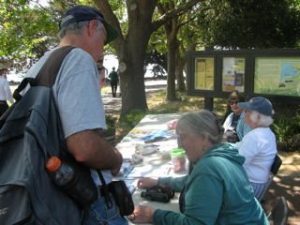Return of the Terns
By Ilana DeBare
The cement stretched for acres around us, cracked and neglected, weeds springing up every few feet through the cracks. It reminded me of a scene from some post-apocalyptic science fiction movie, or from Alan Weisman’s fascinating book The World Without Us, in which he extrapolates what would happen to the planet if humans were to suddenly vanish.

But it wasn’t anything quite so dramatic. We were crossing an abandoned runway at the former Alameda Naval Air Station.
And we were riding in, of all things, an old-fashioned yellow school bus – on the annual Return of the Terns tour.
Each June, the East Bay Regional Park District joins with other groups including Golden Gate Bird Alliance to host bus tours of the breeding colony of endangered California Least Terns at the old Alameda naval air station.
The area is normally closed to the public to prevent disruption of the tern nests. But on Saturday, we were able to drive within yards of the tern colony, provided we didn’t get off the bus or make loud noises.
This may be one of the most unusual birding sites in the world. Forget images of birding in leafy groves or reedy marshes. Least Terns traditionally nest on flat strips of sand or gravel — wide-open surfaces that seem frighteningly vulnerable but give them a good view of potential predators.
Decades ago, the terns apparently decided that the airstrip’s tarmac would be a good substitute for their vanishing beaches. They started returning and nesting here each spring despite the constant takeoffs and landings.
These were California Least Terns — the West Coast subspecies of the smallest kind of tern, which were placed on federal and state endangered species lists in 1970. So the fact that they were trying to breed here was a big deal. Over the past 30 years, volunteers with Friends of the Alameda Wildlife Refuge — a committee of Golden Gate Bird Alliance — have worked with East Bay Regional Parks, the Navy and the U.S. Fish and Wildlife Service to nurture and protect the colony. (GGBA is still pushing to get the nesting area declared an official wildlife refuge.)

To reach the tern colony on Saturday, our school bus crossed over large stretches of cracking and weeded tarmac. Far ahead of us, the Oz-like towers of downtown San Francisco shimmered across the Bay. On our left, an adult Canada Goose and its goslings waddled obliviously across the old runway. (Terns aren’t the only birds that breed at the old air base.)
Then we reached the tern colony — a ten-acre section of tarmac enclosed with wire fencing to keep out stray dogs, cats and humans, covered with a layer of sand imported from Angel Island, and dotted with shells and small structures provided by volunteers to shelter the tern chicks. The area also held a number of small white markers with numbers, used by biologists to map and track nests from a distance.
Peering out the windows like schoolkids on a field trip, we saw and heard dozens of terns swooping through the air — males bringing fish to their chicks or mates. We could see females sitting on nests, which are little more than indentations in the sand. And every so often we glimpsed a fuzzy gray chick peeking out from under its mother or hiding from the sun in a section of conveniently-placed terra cotta pipe.
It was a hot day, hotter than is comfortable for the chicks, who don’t have the same body-temperature control mechanisms as adults. The terns face a variety of challenges to their survival — man-made challenges such as loss of habitat to development, along with traditional challenges such as predators (raptors, ravens etc.), food supply and weather.
With some 300-350 nesting pairs, Alameda Point is the most productive breeding colony of Least Terns on the West Coast. But even so, 10 to 20 percent of the chicks don’t make it to adulthood.
Statewide, the number of California Least Tern nesting attempts has fallen from 8,173 in 2006 to 6,404 in 2011, according to the U.S. Fish & Wildlife Service. The number of fledglings fell even more starkly, from 3.108 in 2006 to 1,106 last year.
These declines make the Alameda site — as unlikely and science-fiction-like as it seems — more important than ever. About 17 percent of all the fledglings on the West Coast come from Alameda Point.
After about 40 minutes of watching the birds, we headed back to Crab Cove Visitor Center to let the next group have a turn on the bus. Outside the center, volunteers with Friends of the Alameda Wildlife Refuge were staffing an information table.
As a relative newcomer to GGBA, this was my first visit to the tern colony. But the FAWR/GGBA volunteers have been visiting for decades, both before and after closure of the naval base — monitoring the nests, documenting the incidence of predators, and enhancing and fencing the site while the terns are wintering in Central or South America. They’ve seen night skies bright with constellations over the tarmac. They’ve seen rainbows that end at Alameda Point.
They’ve also been determined advocates in a long-running battle to create an official wildlife reserve at Alameda Point, and to fend off development proposals that would threaten the terns.

My own takeaway from Return of the Terns was how resilient these creatures are. They’re so small — about as long as an Aidell’s sausage, and hardly thicker. Faced with the loss of their traditional breeding habitats, they found a new one under the noses of military jets.
The Alameda terns are visible evidence of how wildlife can coexist with us, even in the most urban settings.
But then you look at that view of San Francisco from the airport tarmac, and you understand why developers have been itching to get their hands on Alameda Point for years.
Or you think about climate change, and wonder what will happen to future generations of tern chicks if hot sunny days like Saturday become a norm.
The terns are resilient — but only if we give them a chance.
—————————
Want to help support the Alameda tern colony and create a permanent wildlife refuge at Alameda Point? Get involved with Friends of the Alameda Wildlife Refuge; one woman on my bus said that a FAWR work day helping safeguard the nest area was one of the most fulfilling days she’d ever spent in her life! Or donate to GGBA/FAWR. You can earmark your gift to support our advocacy work on behalf of the terns.

